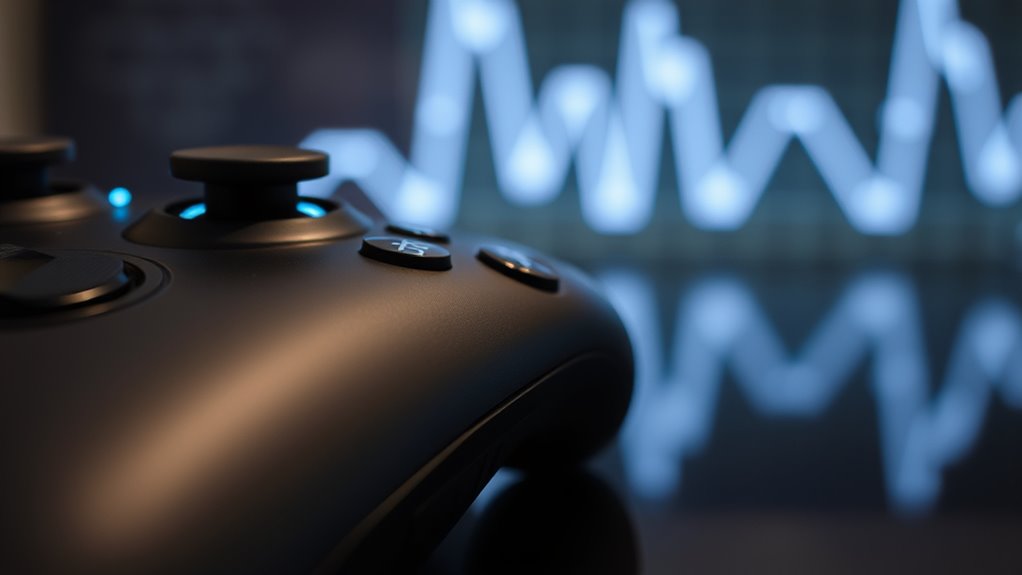In cloud gaming, even a millisecond can considerably affect how responsive and smooth your gameplay feels. Latency involves the time it takes for your input to reach the server, be processed, and for the visual feedback to return to your screen. Small delays cause lag, making actions feel sluggish or out of sync, which can ruin immersion. Understanding how physics, distance, and network factors influence these tiny timeframes helps explain why low latency matters so much—keep exploring to learn more.
Key Takeaways
- Cloud gaming latency involves input lag, network delay, and processing time, all affecting game responsiveness.
- Physical distance from data centers increases latency due to longer data travel, impacting gameplay quality.
- Under 30 ms latency is ideal; over 100 ms causes noticeable lag and responsiveness issues.
- Network congestion and jitter worsen latency, leading to choppy, unresponsive gaming experiences.
- Optimizing hardware, infrastructure, and server placement reduces latency, enhancing real-time cloud gaming performance.

Have you ever wondered why cloud gaming sometimes feels sluggish or unresponsive? The answer lies in latency—the tiny delays that stack up between your input and what you see on screen. Understanding how latency is measured and what influences it can help you grasp why your gaming experience might suffer and what can be done about it. One way to measure input-to-action latency is by using a high-speed camera that records both your input device and your display. If you press a button and see the result after six frames at 120 frames per second, that’s about 50 milliseconds of delay. However, this method isn’t perfect; factors like camera quality, lighting, and human reaction introduce errors, making measurements less precise. Network latency tests with services like Speedtest.net measure ping, but they often don’t reflect the true delay to specific cloud gaming servers. Some platforms, such as NVIDIA GeForce NOW, provide built-in latency tests that measure ping directly to their servers, offering a more accurate picture of your real-world response times. Additionally, performance analytics tools like GameBench Labs can monitor real-time network performance and system responsiveness, giving users a clearer understanding of latency effects in their specific setup.
Measuring cloud gaming latency involves high-speed cameras and server ping tests for more accurate results.
The overall latency in cloud gaming comprises several components. Input lag is the delay from when you make a command to when the game processes it. It’s especially critical in fast-paced multiplayer games where milliseconds can change the outcome. Network delay is the time it takes for data to travel between your device and the cloud server, heavily influenced by physical distance and network congestion. Processing time is how long the cloud servers take to process your input, render frames, and send the visuals back to you. When these components add up, the total latency can considerably impact how responsive the game feels. Even a slight increase can cause noticeable lag, disrupting immersion and gameplay flow.
Physical distance plays a major role. The farther you are from the server, the more data has to travel, increasing ping. Experiments show that latency can be 40 to 150 milliseconds higher than local execution when you’re far from data centers. Round-trip times over WLAN vary from 30 ms to 380 ms, while cellular networks like UMTS can reach 1050 ms, illustrating how much network medium and infrastructure influence responsiveness. During peak hours, network congestion worsens delays by causing packet loss and longer transmission times. To improve this, data centers should be located closer to user clusters, reducing physical distance and improving quality.
Latency under 30 milliseconds is considered ideal for cloud gaming, providing smooth, responsive gameplay. Above 100 ms, players notice input and visual delays that hurt performance. When latency exceeds 150 ms, gameplay becomes sluggish and unresponsive, destroying immersion. Variations in delay, called jitter, also make gameplay choppy, making consistent responsiveness challenging. High latency creates mismatches between actions and feedback, undermining fairness and competitiveness. Large centralized data centers often struggle with latency issues for distant users, highlighting the importance of infrastructure design. Minimizing latency isn’t just about faster hardware; it’s about understanding these physics and optimizing every component to keep your gaming experience smooth and responsive.
Frequently Asked Questions
How Does Latency Affect Competitive Gaming Performance?
Latency directly impacts your competitive gaming performance by delaying your actions and responses. Even a small delay, like 10 milliseconds, can cause you to miss vital shots or make mistakes, especially in fast-paced games. High latency makes your controls feel sluggish, reducing your accuracy and reaction time. To stay competitive, you need low latency, which guarantees your inputs are registered instantly, giving you an edge over opponents.
Can Hardware Improvements Reduce Cloud Gaming Latency?
You wonder if hardware improvements can cut cloud gaming latency. While faster GPUs and smarter rendering techniques speed up processing, they can’t eliminate network delays caused by physical distance and internet quality. Think of hardware upgrades as sharpening a blade—they improve performance but can’t cut through the entire problem. To truly reduce latency, you need a combination of better hardware and optimized networking, especially via edge computing and local proximity.
What Role Does Internet Speed Play in Latency?
You might think faster internet speed always means lower latency, but that’s not entirely true. While a speed of at least 30 Mbps helps stream high-quality games smoothly, other factors like data routing, network congestion, and connection type also impact latency. A wired Ethernet connection or a 5 GHz Wi-Fi can reduce delays more effectively than just increasing your speed, ensuring a better gaming experience.
Are There Differences in Latency Across Gaming Platforms?
Did you know latency varies up to 100 milliseconds across gaming platforms? You’ll notice these differences firsthand—cloud gaming depends on remote servers, adding more lag, while consoles and PCs process locally for quicker response. Mobile devices and browser-based games often face higher delays due to hardware limits or browser overhead. So, your experience depends heavily on the platform’s processing approach, infrastructure, and your network quality.
How Is Latency Measured in Cloud Gaming Environments?
You measure latency in cloud gaming by combining different methods. Use a high-speed camera to record input actions and screen responses, counting frames to estimate delay. Employ software tools that detect game state changes for automated measurements. Also, run ping tests to assess network round-trip times. Combining these approaches gives you a thorough view of total latency, helping to identify delays from hardware, network, or server issues to improve your gaming experience.
Conclusion
Understanding cloud gaming latency shows how even a single millisecond impacts your experience. Imagine playing a fast-paced shooter where every delay can mean the difference between victory and defeat. For instance, if your connection adds just 10 milliseconds of lag, you might miss vital shots or reactions. By minimizing latency, developers can create smoother, more responsive gameplay, ensuring you stay immersed and competitive. Ultimately, mastering millisecond physics makes your gaming experience more seamless and enjoyable.








